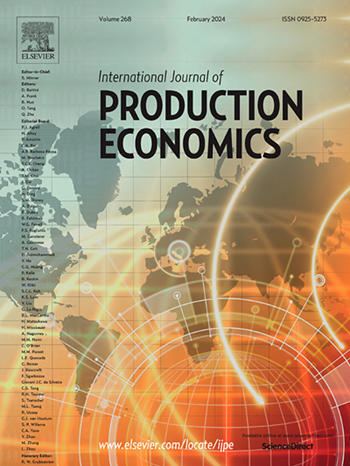竞争还是合作:直播平台生鲜配送模式优化策略
IF 9.8
1区 工程技术
Q1 ENGINEERING, INDUSTRIAL
引用次数: 0
摘要
近年来,在线销售生鲜农产品越来越受欢迎,例如,许多拥有自建配送系统的电子零售商(如亚马逊和京东)和直播平台(如东买)都推出了自己的生鲜农产品私人标签。此外,一些电子零售商正在采用直播技术(例如京东直播)来销售私人生鲜农产品标签。在这种情况下,直播平台需要就使用哪种交付模式做出战略决策:PDM(由电子零售商运营的平台交付模式)还是TDM(第三方交付模式)。为了应对这些挑战,本研究开发了四个理论模型,并提供了关键的管理见解。研究结果表明,无论电子零售商是否进入直播市场,交付服务水平差异和基础市场潜力都会对直播平台的最优交付模式策略产生显著影响。具体来说,直播平台应该选择PDM作为其自有生鲜产品标签,因为它们的基础市场潜力相对较大。对于基础市场潜力相对较低的生鲜农产品,配送模式的选择取决于配送服务水平的差异。此外,电子零售商进入直播市场将导致直播平台更愿意选择TDM。当考虑生鲜产品的单位生产成本、生鲜产品的数量损失、电子零售商拥有的两个独立部门以及不同的保鲜努力成本系数时,这些结果仍然成立。本文章由计算机程序翻译,如有差异,请以英文原文为准。
Competition or co-opetition: Optimal fresh produce delivery mode strategy for livestreaming platform
In recent years, selling fresh produce online has become increasingly popular, for instance, many e-tailers (e.g., Amazon and JD) with self-built delivery systems and livestreaming platforms (e.g., East Buy) have launched their private fresh produce labels. Moreover, some e-tailers are adopting livestreaming technology (e.g., JD Live) to sell private fresh produce labels. In these contexts, livestreaming platforms need to make strategic decisions about which delivery mode to use: PDM (platform delivery mode operated by e-tailers) or TDM (third-party delivery mode). To address these challenges, this study develops four theoretical models and provides key managerial insights. The findings indicate that, regardless of whether e-tailers enter the livestreaming market, delivery service level difference and base market potential will have a significant impact on livestreaming platforms’ optimal delivery mode strategies. Specifically, livestreaming platforms should choose PDM for their private fresh produce labels with relatively large base market potential. For fresh produce with relatively low base market potential, the delivery mode choice between PDM and TDM depends on the difference in delivery service levels. Furthermore, e-tailers entering the livestreaming market will lead livestreaming platforms to be more willing to choose TDM. These findings hold robust when considering the unit production cost of fresh produce, quantity loss of fresh produce, two independent departments owned by e-tailers and different freshness-keeping effort cost coefficients.
求助全文
通过发布文献求助,成功后即可免费获取论文全文。
去求助
来源期刊
CiteScore
21.40
自引率
7.50%
发文量
266
审稿时长
52 days
期刊介绍:
The International Journal of Production Economics focuses on the interface between engineering and management. It covers all aspects of manufacturing and process industries, as well as production in general. The journal is interdisciplinary, considering activities throughout the product life cycle and material flow cycle. It aims to disseminate knowledge for improving industrial practice and strengthening the theoretical base for decision making. The journal serves as a forum for exchanging ideas and presenting new developments in theory and application, combining academic standards with practical value for industrial applications.

 求助内容:
求助内容: 应助结果提醒方式:
应助结果提醒方式:


